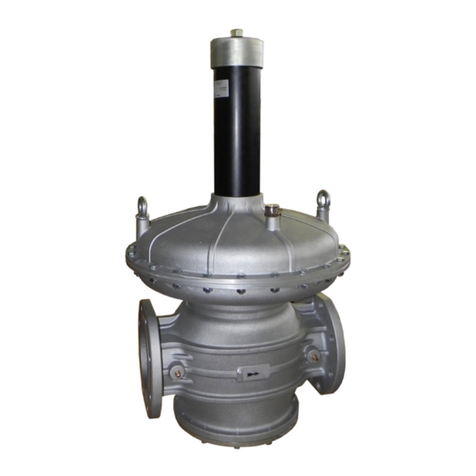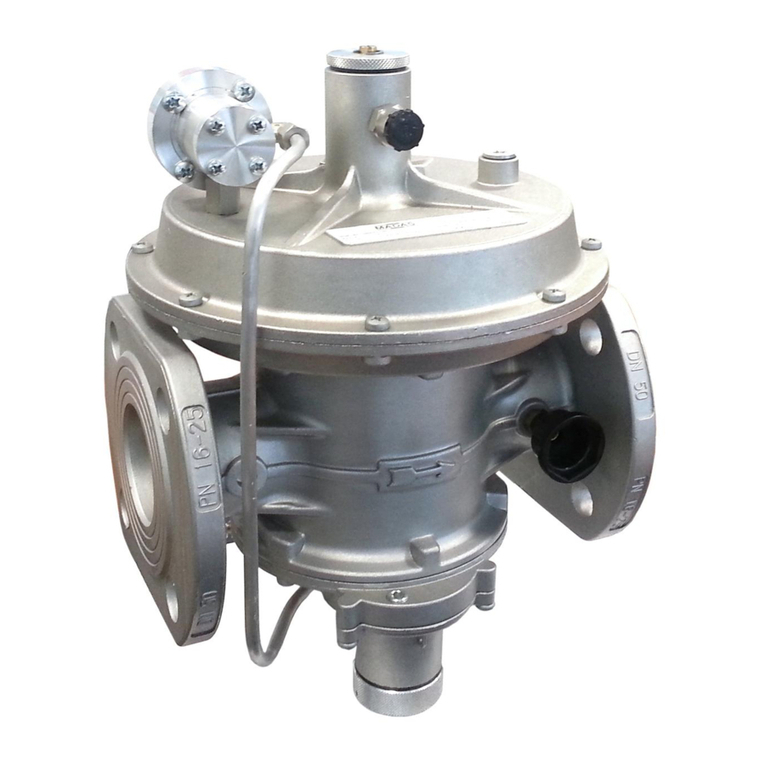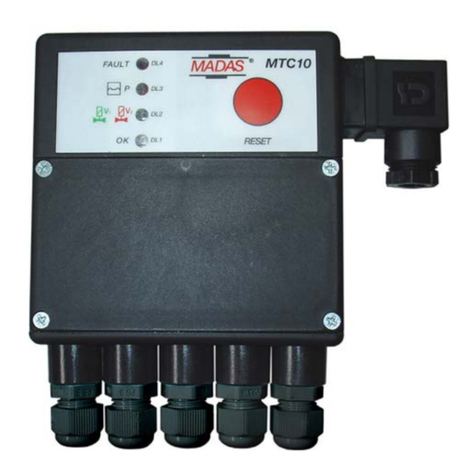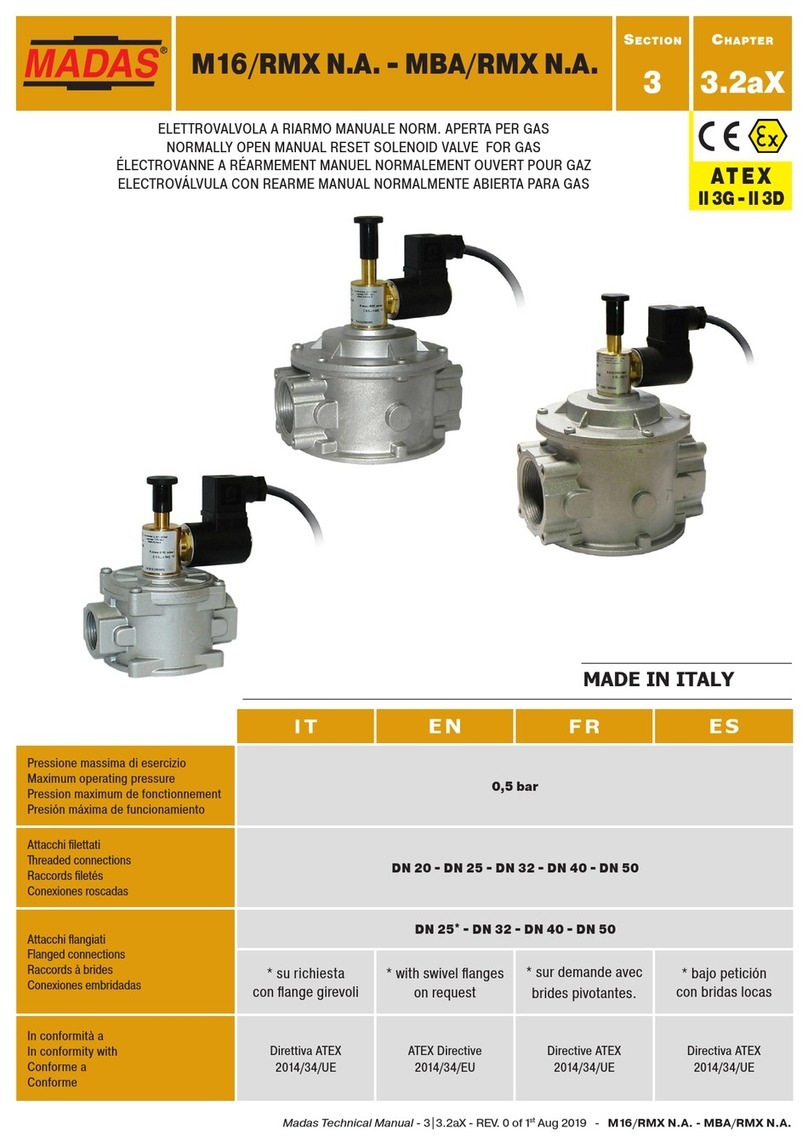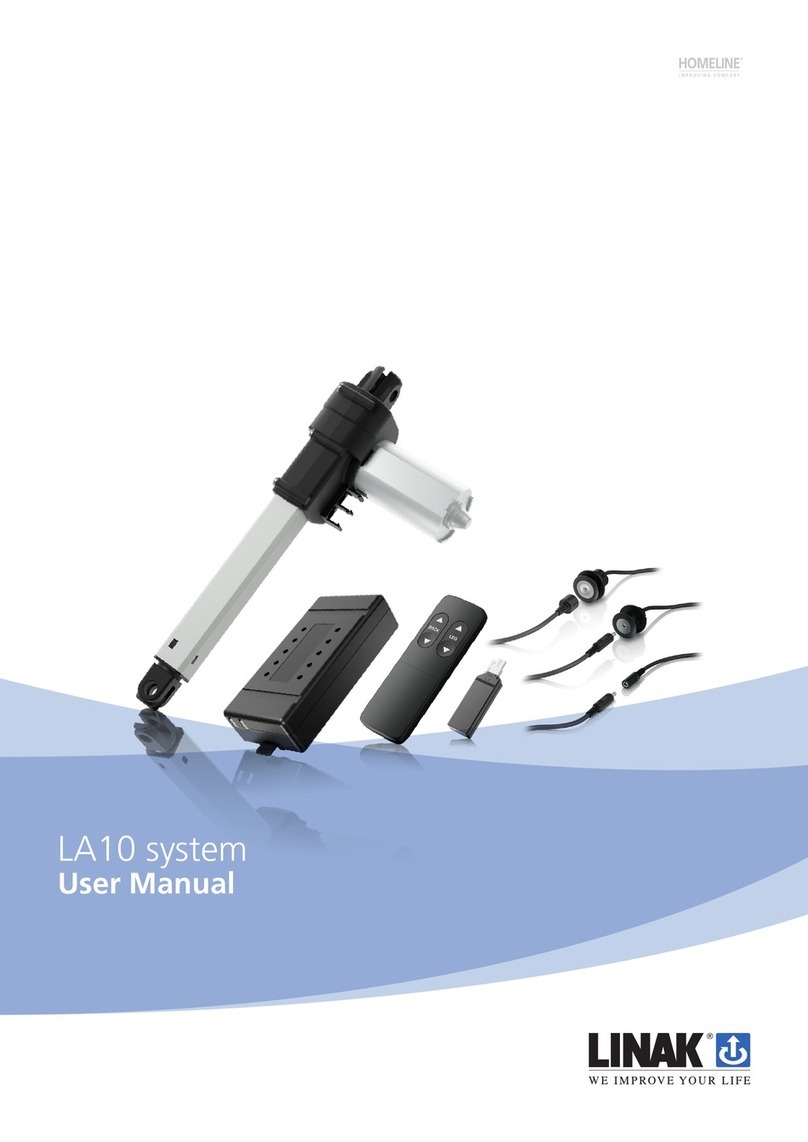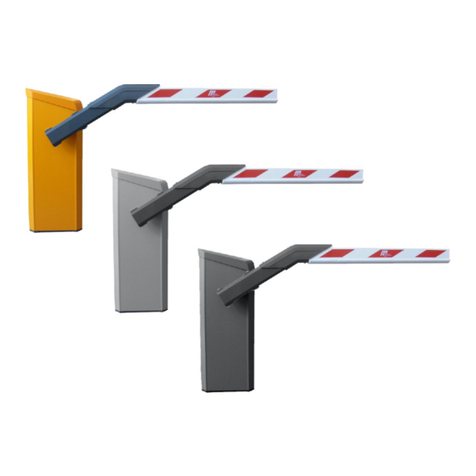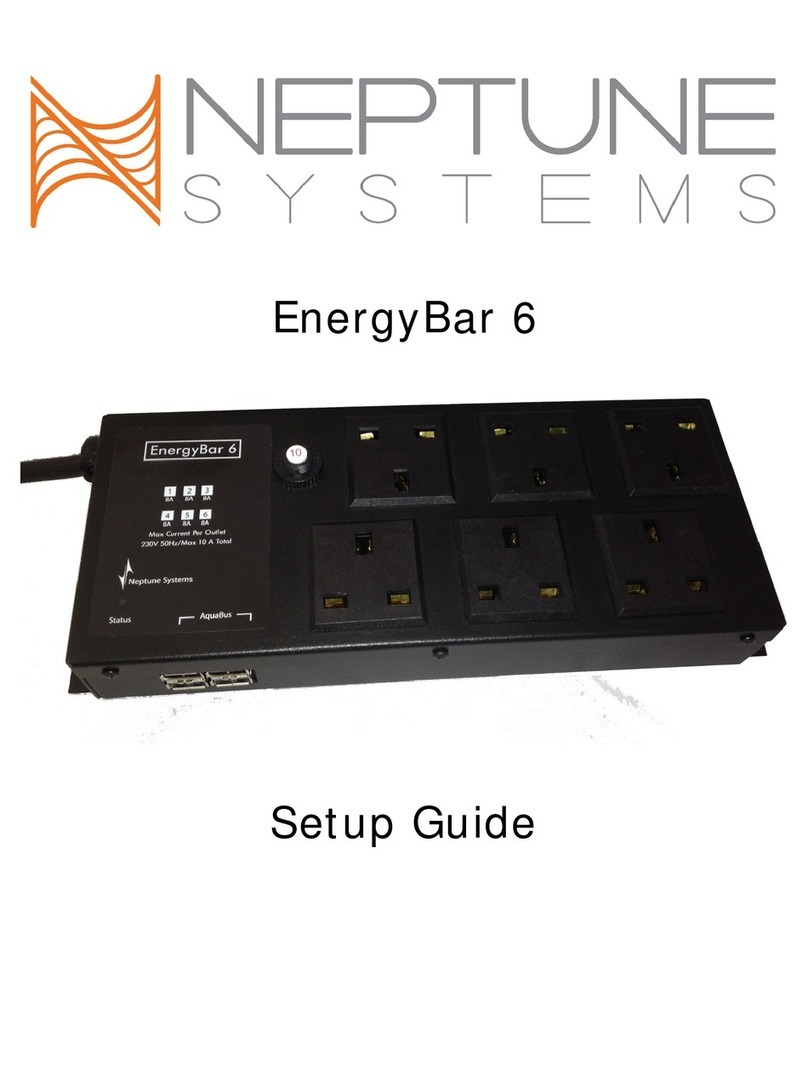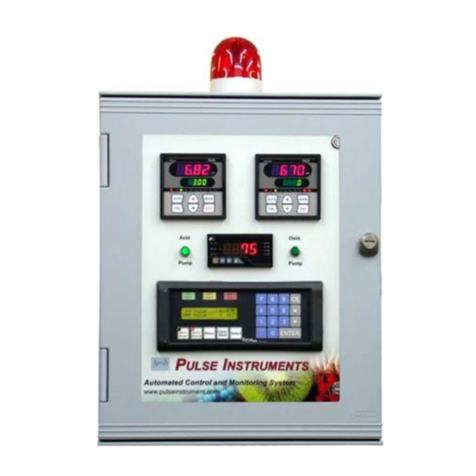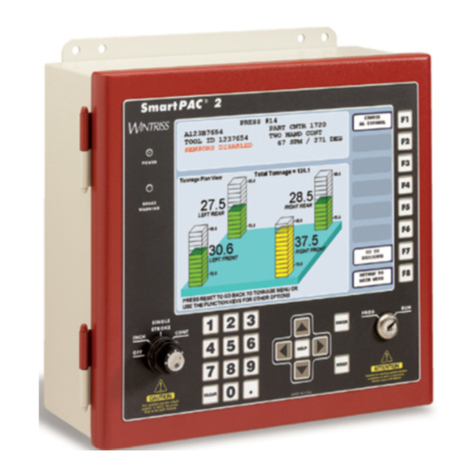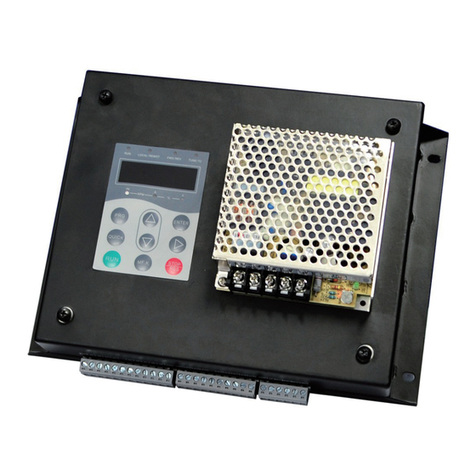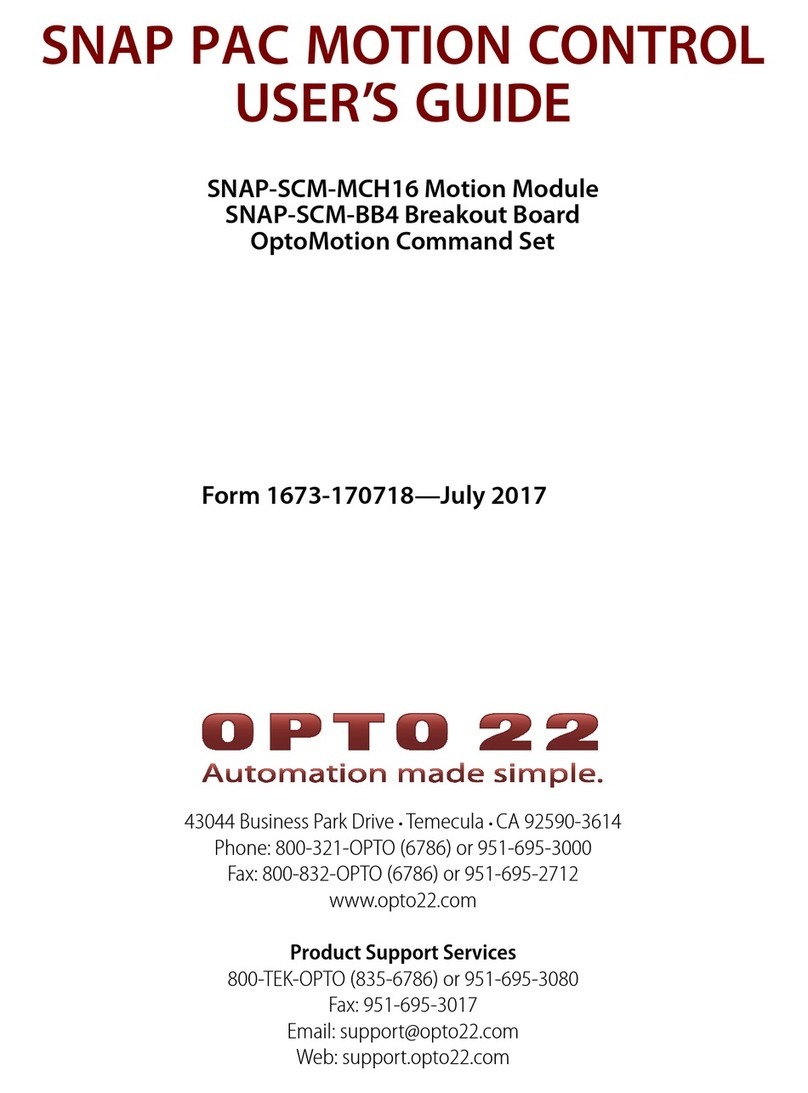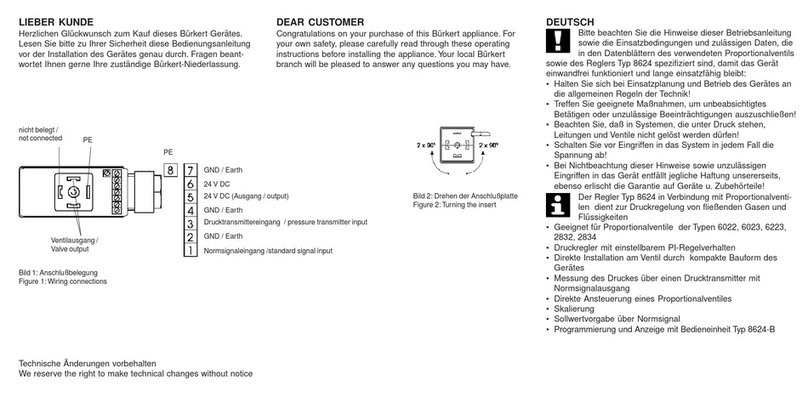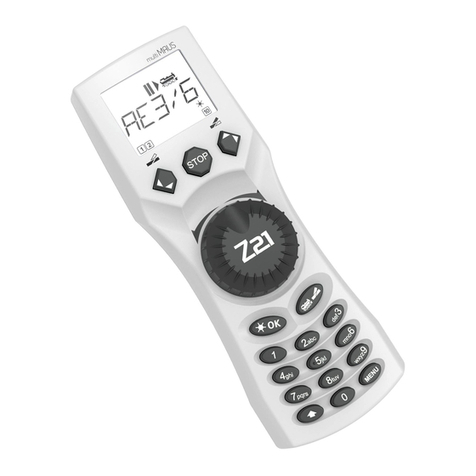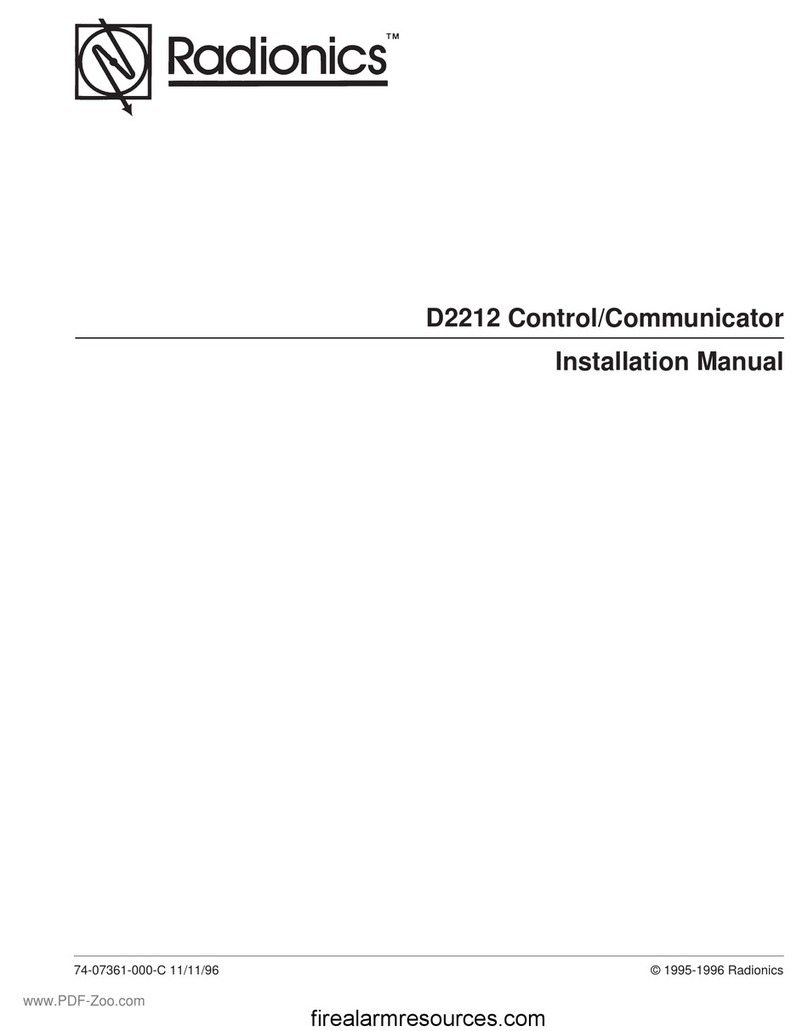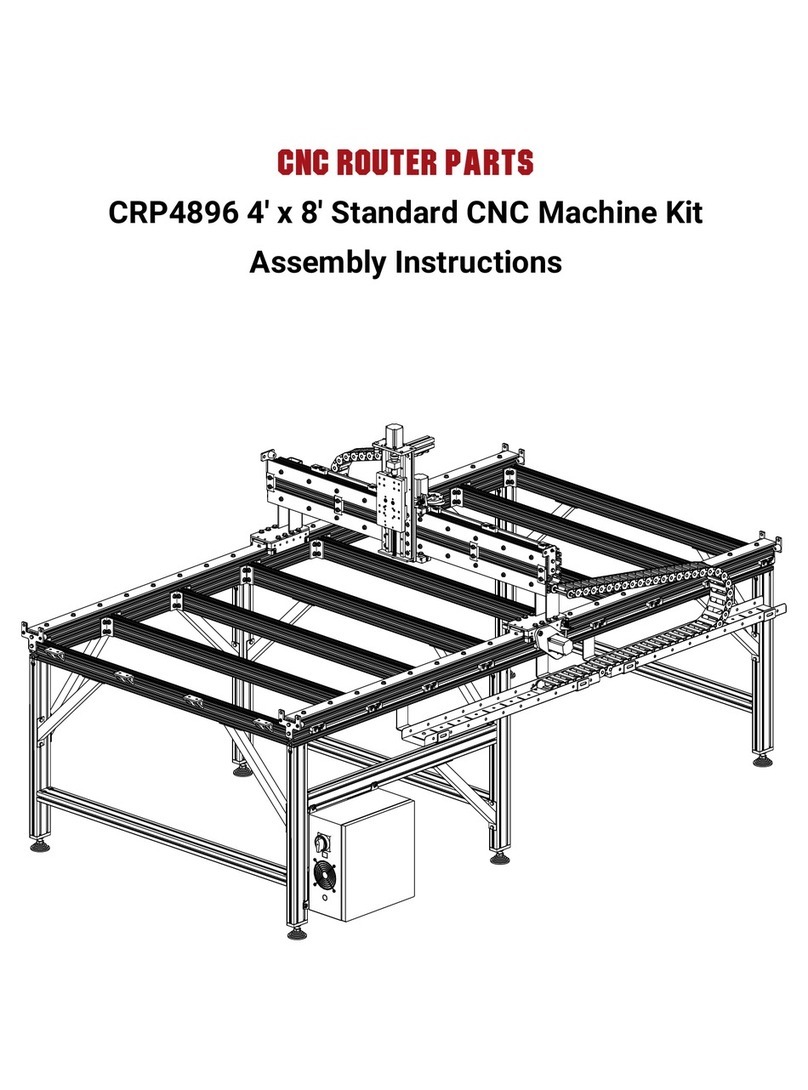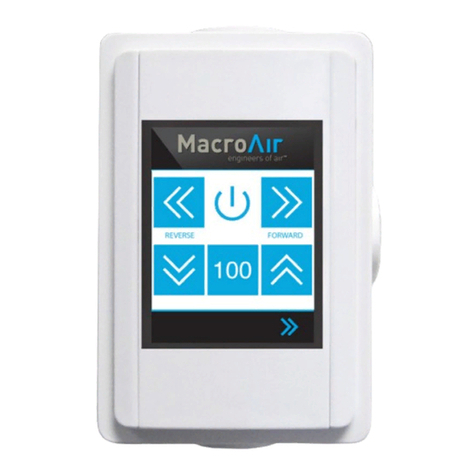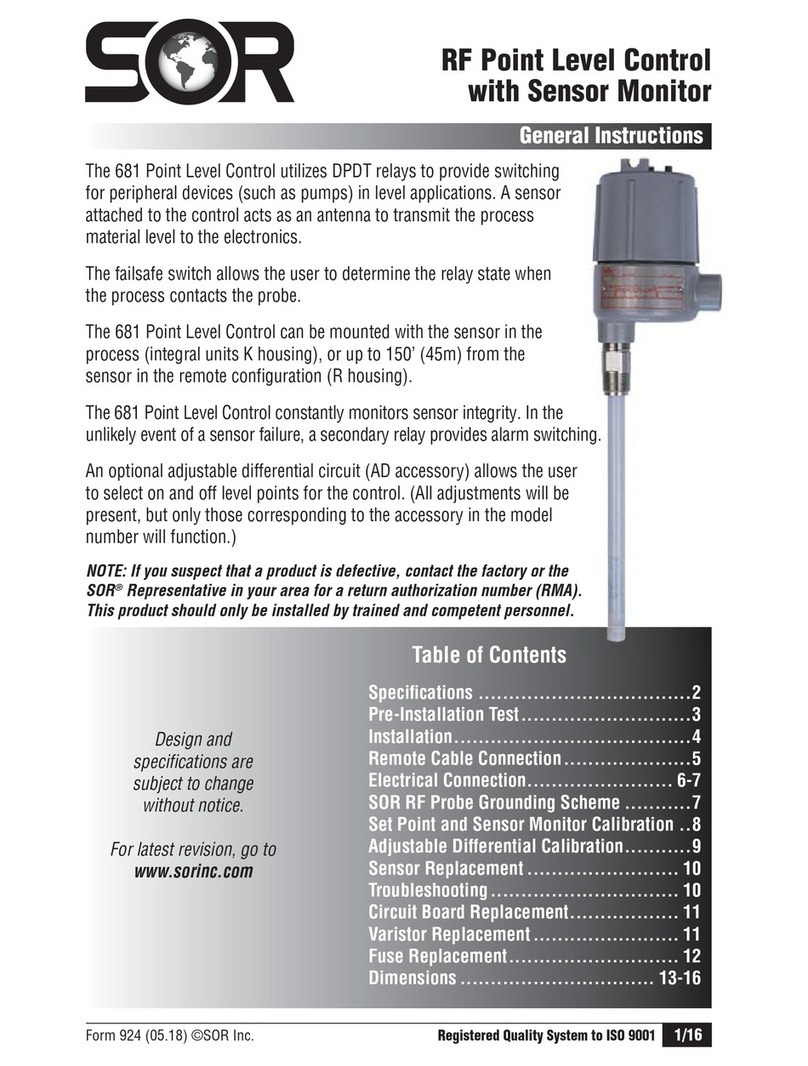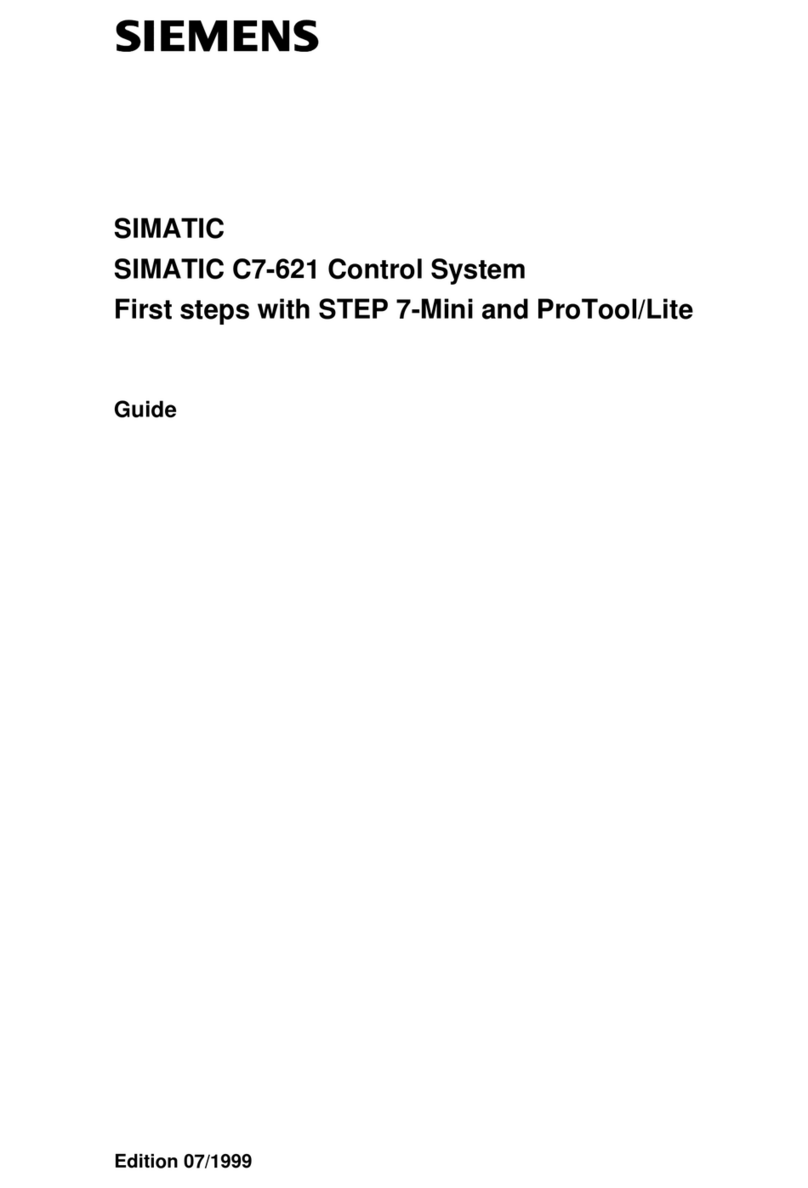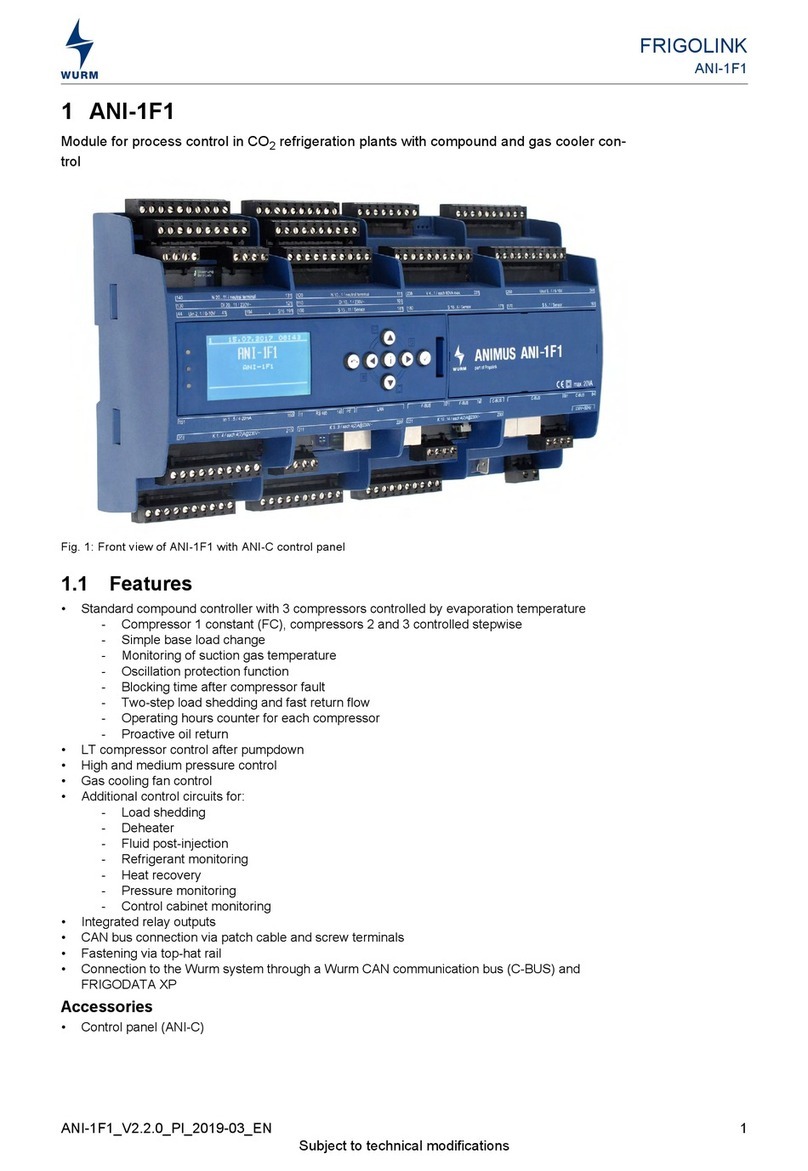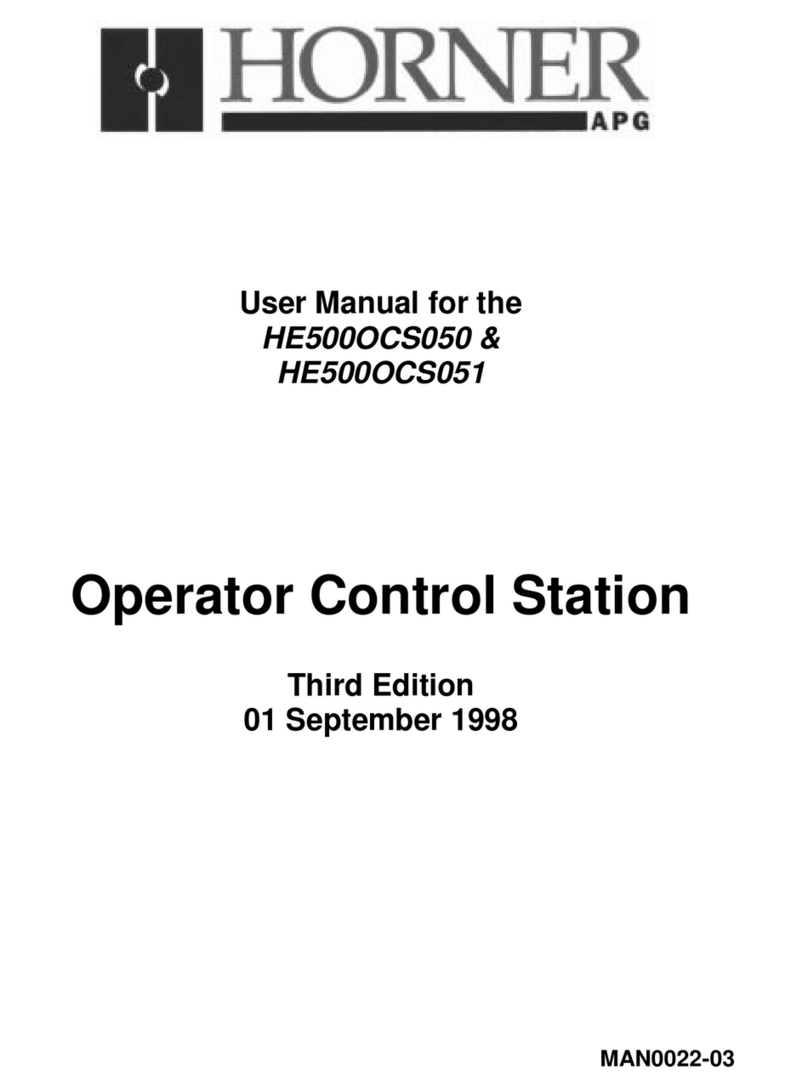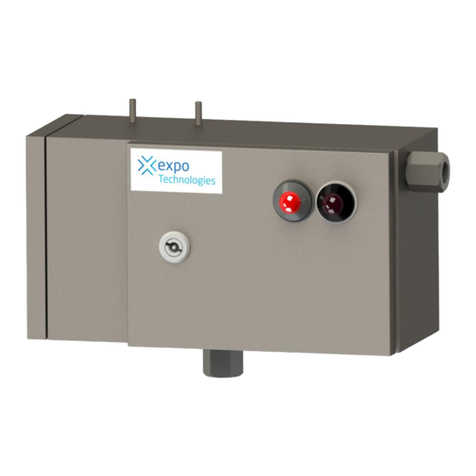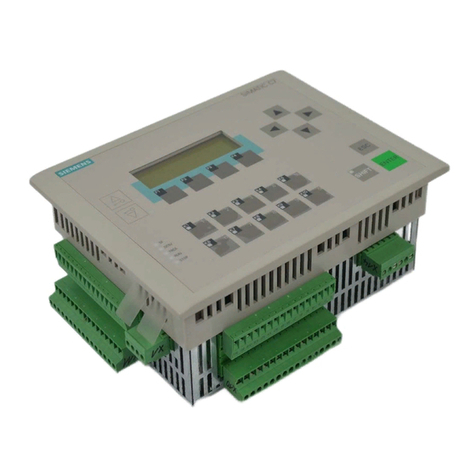Madas XV(F)-1-3-6 User manual

ELETTROVALVOLA AUTOMATICA NORMALMENTE CHIUSA PER GAS AD APERTURA RAPIDA
AUTOMATIC NORMALLY CLOSED FAST OPENING SOLENOID VALVE FOR GAS
ÉLECTROVANNE AUTOMATIQUE NORMALEMENT FERMEES POUR GAZ
À OUVERTURE RAPIDE
ELECTROVÁLVULA AUTOMÁTICA NORMALMENTE CERRADA PARA GAS CON APERTURA RÁPIDA
XV(F)-1-3-6
IT EN FR ES
Pressione massima di esercizio
Maximum operating pressure
Pression maximum de fonctionnement
Presión máxima de funcionamiento
3 - 6 bar (DN 32 - DN 32 FL - DN 40 - DN 40 FL - DN 50 - DN 50 FL)
0,5 - 1 - 3 - 6 bar (DN 65 - DN 80 - DN 100 - DN 125 - DN 150)
Attacchi filettati / Threaded connections
Raccords filetés / Conexiones roscadas
DN 32 - DN 40 - DN 50
Attacchi flangiati/ Flanged connections
Raccords à brides / Conexiones embridadas
DN 32 - DN 40 - DN 50 - DN 65 - DN 80 - DN 100 - DN 125 - DN 150
Norma di riferimento
Reference standard
Norme de référence
Patrón de referencia
EN 161
In conformità a *
In conformity with *
Conforme a *
Conforme *
Regolamento (UE)
2016/426
Direttiva ATEX
2014/34/UE
Direttiva PED
2014/68/UE
Regulation (EU)
2016/426
ATEX Directive
2014/34/EU
PED Directive
2014/68/EU
Règlement (UE)
2016/426
Directive ATEX
2014/34/UE
Directive PED
2014/68/UE
Reglamento (UE)
2016/426
Directiva ATEX
2014/34/UE
Directiva PED
2014/68/UE
* Vedere tabella conformità in 9.0 / See compliance table in 9.0 / Voir le tableau de conformité en 9.0 / Véase tabla de cumplimiento en 9.0
Chapter
1.5cX
SeC tion
1
Madas Technical Manual - 1|1.5cX - REV. 1 of 10th Sep 2020 - XV(F)-1-3-6
CE-51CR4682
MADE IN ITALY
0051
0497
II 3G - II 3D
ATEX
II 3G - II 3D

2
ES FR EN IT
Madas Technical Manual - 1|1.5cX - REV. 1 of 10th Sep 2020XV(F)-1-3-6
INDICE INDEX INDEX ÍNDICE
pag.
Italiano ........................................................................................................................................................ 3
English ........................................................................................................................................................ 13
Français ...................................................................................................................................................... 23
Español ....................................................................................................................................................... 33
Disegni - Drawings - Dessins - Diseños. ........................................................................................................... 43
Dimensioni (tabella 1) ................................................................................................................................... 51
Dimensions (table 1) .....................................................................................................................................
Dimensions (tableau 1) ..................................................................................................................................
Dimensiones (tabla 1) ..................................................................................................................................
Livello SIL (tabella 2) - SIL Level (table 2) - Niveau SIL (tableau 2) - Nivel SIL (tabla 2)............................................ 52
Diagramma - Diagram - Diagramme - Diagrama ∆p............................................................................................. 53
Bobine (tabella 3).......................................................................................................................................... 54
Coils (table 3) ..............................................................................................................................................
Bobines (tableau 3) ......................................................................................................................................
Bobinas (tabla 3)...........................................................................................................................................
Codifica prodotto / Product encoding / Codification du produit / Codificación del producto....................................... 55

3
IT EN FR ES
XV(F)-1-3-6Madas Technical Manual - 1|1.5cX - REV. 1 of 10th Sep 2020
1.0 GENERALITÀ
Il presente manuale illustra come installare, far funzionare e utilizzare il dispositivo in modo sicuro.
Le istruzioni per l’uso devono essere SEMPRE disponibili nell’impianto dove è installato il dispositivo.
ATTENZIONE: le operazioni di installazione/cablaggio/manutenzione devono essere eseguite
da personale qualificato (come indicato in 1.3) utilizzando adeguati dispositivi di protezione
individuale (DPI).
Per eventuali informazioni relative alle operazioni di installazione/cablaggio/manutenzione o in caso di problemi non
risolvibili con l’utilizzo delle istruzioni è possibile contattare il produttore utilizzando indirizzo e recapiti telefonici riportati
in ultima pagina.
1.1 DESCRIZIONE
Elettrovalvole di intercettazione per gas automatiche normalmente chiuse ad apertura rapida. Aprono il flusso del gas quando la
bobina viene alimentata elettricamente e lo chiudono quando viene tolta tensione. Possono essere comandate da pressostati,
termostati, ecc.
Possono essere fornite dotate di CPI switch per la segnalazione a distanza della posizione dell’otturatore (chiuso) della valvola.
Il CPI è installabile anche successivamente SOLO SE l’apparecchio è dotato di apposita predisposizione (tappo sotto al corpo
valvola). Ulteriori informazioni riguardanti il CPI switch sono riportate in 6.0.
Norme di riferimento: EN 161 - EN 13611 - EN 60079-0-7-14-15-31.
1.2 LEGENDA SIMBOLI
1.3 PERSONALE QUALIFICATO
Trattasi di persone che:
•Hanno dimestichezza con l’installazione, il montaggio, la messa in servizio e la manutenzione del prodotto;
•Sono a conoscenza delle normative in vigore nella regione o paese in materia di installazione e sicurezza;
•Hanno istruzione sul pronto soccorso.
1.4 USO DI PARTI DI RICAMBIO NON ORIGINALI
•In caso di manutenzione o sostituzione di componenti di ricambio (es. bobina, ecc.) devono essere utilizzati SOLAMENTE
quelli indicati dal fabbricante. L’utilizzo di componenti differenti, oltre a far decadere la garanzia del prodotto, potrebbe
compromettere il corretto funzionamento dello stesso.
•Il fabbricante non è responsabile di malfunzionamenti derivanti da manomissioni non autorizzate o utilizzo di ricambi non
originali.
1.5 UTILIZZO NON APPROPRIATO
•Il prodotto deve essere utilizzato unicamente allo scopo per il quale è stato costruito.
•Non è consentito l’utilizzo con fluidi differenti da quelli indicati.
•Non devono essere superati in nessun caso i dati tecnici indicati in targhetta. E’ cura dell’utilizzatore finale o dell’installatore,
adottare corretti sistemi a protezione dell’apparecchio che impediscano il superamento della pressione massima indicata
in targhetta.
•Il fabbricante non è responsabile per danni causati da un utilizzo improprio dell’apparecchio.
ATTENZIONE: Viene
richiamata l’attenzione su
dettagli tecnici rivolti al
personale qualificato.
PERICOLO:
In caso di inosservanza
oltre a danni a beni materiali, possono
essere procurati danni alle persone e/o
animali domestici.
PERICOLO: In caso di
inosservanza possono
essere procurati danni a
beni materiali.

4
ES FR EN IT
XV(F)-1-3-6 Madas Technical Manual - 1|1.5cX - REV. 1 of 10th Sep 2020
2.0 DATI TECNICI
• Impiego : gas non aggressivi delle tre famiglie (gas secchi)
• Temperatura ambiente (TS) : -20 ÷ +60 °C
• Tensioni di alimentazione (vedere tabella 2) : 24 Vdc - 24 V/50 Hz - 110 V/50-60 Hz - 230 V/50-60 Hz*
• Tolleranza su tensione di alimentazione : -15% ... +10%
• Cablaggio elettrico : cavo elettrico l=3 metri con terminali capicorda
• N° cicli/ora** : ~90 (tempo ON 10s - tempo OFF 30s)
• Potenza assorbita : vedere tabella 2
• Pressione massima di esercizio
DN 32 - DN 40 - DN 50 : 3 bar o 6 bar (vedere etichetta prodotto)
DN 65 - DN 80 - DN 100 - DN 125 - DN 150 : 500 mbar,1 bar, 3 bar o 6 bar (vedere etichetta prodotto)
• Tempo di di apertura : <1 s
• Tempo di chiusura : <1 s
• Grado di protezione : IP65
• Modo di protezione bobina : II 3G Ex nC IIC T4 Gc X - II 3D Ex tc IIIC T135°C Dc X
• Classe : A
• Resistenza meccanica : Gruppo 2
• Attacchi filettati Rp : (DN 32 - DN 40 - DN 50) secondo EN 10226
• Attacchi flangiati accoppiabili con flange PN 16 : (DN 32 - DN 40 - DN 50 - DN 65 - DN 80 - DN 100 - DN 125 - DN 150)
ISO 7005 / EN 1092-1
• Attacchi filettati NPT o flangiati ANSI 150 : su richiesta
• In conformità a
(vedere anche tabella a pag. 11)
: Regolamento (UE) 2016/426 (Apparecchichebrucianocarburantigassosi)
EN 60079-0-7-14-15-31 - Direttiva ATEX 2014/34/UE
Direttiva PED 2014/68/UE
(versioni aventi P.max = 1-3-6 bar)
Directiva EMC 2014/30/UE - Directiva LVD 2014/35/UE
Directiva RoHS II 2011/65/UE
* Solo monofase, l’apparecchio non funziona se alimentato con tensione trifase.
** Per cicli/ora con tempi ON/OFF differenti da quelli indicati contattare il nostro ufficio tecnico
2.1 INDIVIDUAZIONE MODELLI
XV-1 : Apertura rapida P. max 0,5 o 1 bar (vedere etichetta prodotto) ATEX 3G - 3D
XV-3 : Apertura rapida P. max 3 bar ATEX 3G - 3D
XV-6 : Apertura rapida P. max 6 bar ATEX 3G - 3D
XVF-1 : Apertura rapida + regolazione portata P. max 0,5 o 1 bar (vedere etichetta prodotto) ATEX 3G - 3D
XVF-3 : Apertura rapida + regolazione portata P. max 3 bar ATEX 3G - 3D
XVF-6 : Apertura rapida + regolazione portata P. max 6 bar ATEX 3G - 3D
2.2 LIVELLO SIL
Per i modelli conformi al Regolamento (UE) 2016/426 (vedere tabella in 9.0), il livello di SIL della elettrovalvola stand-alone
è SIL 2; quando vengono installate due elettrovalvole in serie e il relativo controllo tenuta (Valve Proving System), certificato
secondo EN 1643, il livello raggiunto è SIL 3, così come indicato sulla norma EN 676:2008. L’elettrovalvola ha livello di PL
d. Per ulteriori dati consultare la tabella SIL LEVEL (tabella 2).
3.0 MESSA IN FUNZIONE DEL DISPOSITIVO
3.1 OPERAZIONI PRELIMINARI ALL’INSTALLAZIONE
Tutte le operazioni di installazione devono essere eseguite in assenza di atmosfera esplosiva.
•E’ necessario chiudere il gas a monte della valvola prima dell’installazione;
•Verificare che la pressione di linea NON SIA SUPERIORE alla pressione massima dichiarata sull’etichetta del prodotto;
•Eventuali tappi di protezione (se presenti) vanno rimossi prima dell’installazione;
•Tubazioni e interni della valvola devono essere liberi da corpi estranei;

5
IT EN FR ES
XV(F)-1-3-6Madas Technical Manual - 1|1.5cX - REV. 1 of 10th Sep 2020
Se l’apparecchio è filettato:
•verificare che la lunghezza del filetto della tubazione non sia eccessiva per non danneggiare il corpo dell’apparecchio
in fase di avvitamento;
Se l’apparecchio è flangiato:
•verificare che le controflange di ingresso e uscita siano perfettamente coassiali e parallele per evitare di sottoporre il
corpo a inutili sforzi meccanici, calcolare inoltre lo spazio per l’inserimento della guarnizione di tenuta;
•Per le fasi di serraggio, è necessario munirsi di una o più chiavi dinamometriche tarate od altri utensili di bloccaggio
controllati;
•Devono essere rispettate le normative di sicurezza, vigenti nel paese di installazione, per quanto riguarda la movimentazione
dei carichi. Qualora l’apparecchio da installare superi il peso consentito, deve essere previsto l’utilizzo di un adeguato
ausilio meccanico e di adeguate imbracature. E’ necessario, durante le fasi di movimentazione, adottare opportune
precauzioni per non danneggiare/rovinare la superficie esterna dell’apparecchio.
•Deve essere prevista, in accordo alla normativa EN 161, l’installazione di un filtro adeguato a monte di un dispositivo di
sicurezza di chiusura del gas;
•In caso di installazione all’esterno, è consigliato prevedere una tettoia di protezione per evitare che l’acqua piovana possa
danneggiare le parti elettriche dell’apparecchio.
•Prima di effettuare connessioni elettriche verificare che la tensione di rete corrisponda con la tensione di alimentazione
indicata sull’etichetta del prodotto;
•Scollegare l’alimentazione prima di procedere al cablaggio;
•In base alla geometria dell’impianto valutare il rischio di formazione di miscela esplosiva all’interno della tubazione;
•Se l’elettrovalvola è installata in prossimità di altre apparecchiature o come parte di un insieme, è necessario
valutare preliminarmente la compatibilità fra l’elettrovalvola e tali apparecchiature;
•Evitare di installare l’elettrovalvola in prossimità di superfici che potrebbero essere danneggiate dalla temperatura
della bobina. ATTENZIONE: la temperatura superficiale potrebbe causare ustioni da contatto. Nel caso sia
installata in ambiente domestico, non deve essere resa accessibile a personale non qualificato;
•Prevedere una protezione da urti o contatti accidentali nel caso l’elettrovalvola sia accessibile a personale non qualificato.
3.2 INSTALLAZIONE (vedere esempi in 3.4)
Apparecchi filettati:
•Assemblare il dispositivo avvitandolo, assieme alle opportune tenute, sull’impianto con tubi e/o raccordi le cui filettature
siano coerenti con la connessione da assemblare.
•Non usare la bobina (3) come leva per l’avvitamento ma servirsi dell’apposito utensile;
•La freccia, indicata sul corpo (6) dell’apparecchio, deve essere rivolta verso l’utenza;
Apparecchi flangiati:
•Assemblare il dispositivo flangiandolo, assieme alle opportune tenute, all’impianto con tubi le cui flange siano coerenti con
la connessione da assemblare. Le guarnizioni devono essere prive di difetti e devono essere centrate tra le flange;
•Se a guarnizioni inserite lo spazio rimanente è eccessivo non cercare di colmare il gap stringendo eccessivamente i bulloni
dell’apparecchio;
•La freccia, indicata sul corpo (6) dell’apparecchio, deve essere rivolta verso l’utenza;
•Inserire all’interno dei bulloni le apposite rondelle per evitare danneggiamenti alle flange in fase di serraggio;
•Durante la fase di serraggio prestare attenzione a non “pizzicare” o danneggiare la guarnizione;
•Serrare i dadi o bulloni gradualmente, secondo uno schema “a croce” (vedere esempio sottoindicato);
•Serrarli, prima al 30%, poi al 60%, fino al 100% della coppia massima (vedere tabella sottostante secondo EN 13611);
Diametro DN 32 DN 40 DN 50 DN 65 DN 80 DN 100 DN 125 DN 150
Coppia max (N.m) 50 50 50 50 50 80 160 160
•Serrare nuovamente ogni dado o bullone in senso orario almeno una volta, fino al raggiungimento dell’uniformità della
coppia massima;

6
ES FR EN IT
XV(F)-1-3-6 Madas Technical Manual - 1|1.5cX - REV. 1 of 10th Sep 2020
Procedure in comune (apparecchi filettati e flangiati):
•Installare il dispositivo SOLO nelle posizioni
consentite (vedere figura a lato);
•Durante l’installazione evitare che detriti o residui
metallici penetrino all’interno dell’apparecchio;
•Garantire un montaggio privo di tensioni meccaniche,
è consigliato l’uso di giunti compensatori anche per
sopperire alle dilatazioni termiche della tubazione;
•In caso sia prevista l’installazione dell’apparecchio in
una rampa, è cura dell’installatore prevedere adeguati
supporti o appoggi correttamente dimensionati, per
sostenere e fissare l’insieme. Non lasciare, mai e per nessun motivo, gravare il peso della rampa solo sulle connessioni
(filettate o flangiate) dei singoli dispositivi;
•In ogni caso dopo l’installazione verificare la tenuta dell’impianto;
•ATTENZIONE: La bobina è fornita con cavo di alimentazione
(2)
pre-cablato di lunghezza pari a 3 metri. Questo cavo
NON può essere sostituito con uno differente e, in caso di danneggiamento, il componente (bobina) deve essere scartato
e sostituito con uno identico ed integro. L’eventuale riparazione (se possibile) può essere eseguita solo dal fabbricante;
•Nell’area pericolosa, cablare le estremità del cavo con apparecchiature omologate protette ad esplosione (Es. Scatola
terminale con protezione “e” o sicurezza aumentata secondo EN 60079-7) usando gli appositi terminali capicorda;
•Colorazione cavi
Fase : marrone (in alternativa nero o grigio)
Neutro : blu
: giallo/verde
•Assicurarsi che i cavi di collegamento siano inseriti correttamente nel terminale elettrico avendo cura che non risultino
schiacciati e/o danneggiati per evitare corto circuiti e interruzioni.
•Prevedere installazione in posa fissa assicurando un’adeguata protezione contro le sollecitazioni meccaniche;
•La bobina
(3)
deve essere collegata a terra utilizzando l’apposita connessione
(1);
•La valvola deve essere collegata a terra tramite la tubazione o mediante altri mezzi (es. ponti a cavi).
Condizioni speciali per un uso sicuro
Il simbolo “X” (posizionato alla fine del modo di protezione) indica particolari condizioni di utilizzo:
• Pulire regolarmente il prodotto per evitare accumuli di polvere;
• La valvola deve essere installata in luoghi a basso rischio di impatto meccanico;
• Rispettare il numero di cicli/h indicati in 2.0 (Dati Tecnici). Per tempi/ciclo diversi contattare l’ufficio tecnico;
• Raggio di curvatura minimo del cavo = 4 Ø, temperatura minima d’installazione -35°C;
• L’apparecchiatura dev’essere protetta contro l’effetto delle scariche dei fulmini;
• Le scintille provocate da urti o attriti su metalli leggeri possono provocare fonti di ignizione, pertanto non devono essere usati
in nessun caso (esempio per regolazioni, manutenzione, ecc.) utensili con superfici corrose;
• Proteggere il prodotto da urti o attriti provocati da altri oggetti;
• Verificare periodicamente l’integrità del trattamento superficiale dissipativo di bobina e connettore;
• Non installare in ambienti nei quali il prodotto si trovi a diretto contatto con gas corrosivi, prodotti chimici, acqua salata, acqua o vapore
(grado d’inquinamento ambientale C3 o medio). Per ogni altra applicazione contattare l’ufficio tecnico per l’analisi di compatibilità;
3.3 INSTALLAZIONE IN LUOGHI A RISCHIO DI ESPLOSIONE (DIRETTIVA 2014/34/UE)
L’elettrovalvola è conforme alla Direttiva 2014/34/UE come apparecchio del gruppo II, categoria 3G e come apparecchio del gruppo
II, categoria 3D; come tale è idonea per essere installata nelle zone 2 e 22 come classificate nell’allegato I alla Direttiva 99/92/CE.
L’elettrovalvola NON è idonea per l’utilizzo nelle zone 1, 21, 0 e 20 come definite nella già citata Direttiva 99/92/CE. Per determinare
la qualifica e l’estensione delle zone pericolose si veda la norma CEI EN 60079-10-1.
L’apparecchio, se installato e sottoposto a manutenzione nel pieno rispetto di tutte le condizioni e istruzioni tecniche riportate nel presente
documento, non costituisce fonte di pericoli specifici: in particolare, in condizioni di normale funzionamento, non è prevista, da parte
dell’elettrovalvola, l’emissione in atmosfera di sostanza infiammabile con modalità tali da originare un’atmosfera esplosiva.
Al momento dell’installazione e della manutenzione è fondamentale rispettare le norme Ex, in particolare EN 60079-14. L’installazione
elettrica deve essere eseguita da personale autorizzato in accordo alle norme nazionali pertinenti.
Non installare l’apparecchio in atmosfere esplosive eccezion fatta per le zone e i gruppi di gas e polveri specificati (indicati in 2.0 e in 6.1).
La successiva applicazione di una verniciatura non conduttiva con spessore > 0,2mm sulla superficie esterna ne vieta l’impiego in
ambienti con atmosfere potenzialmente esplosive in cui sono presenti Gas dei gruppi IIC. Lo spessore della verniciatura deve
essere < 2mm per il gruppo IIB.
Per il gruppo III è necessario prendere idonee precauzioni atte ad evitare l’accumulo di cariche elettrostatiche (es. pulizia con panno
antistatico, ecc.).
P.max Posizioni di installazione
0,5 - 1
bar
3 - 6
bar

7
IT EN FR ES
XV(F)-1-3-6Madas Technical Manual - 1|1.5cX - REV. 1 of 10th Sep 2020
1
2345
9
10
11
rete
utenza
scarico in
aria libera
interno centrale termica
teoia esterna
87
6
9
12
3.4 ESEMPI GENERICI DI INSTALLAZIONE
ESEMPIO 1
1. Elettrovalvola a riarmo manuale M16/RM N.C.
2. Valvola a strappo SM
3. Filtro gas FM
4. Valvola di blocco OPSO serie MVB/1 MAX
5. Regolatore di pressione RG/2MC
6. Elettrovalvola automatica XV-1
ad apertura rapida
7. Dispositivo di comando elettrovalvola
8. Valvola di sfioro MVS/1
9. Manometro e relativo pulsante
10. Gas detector
11. Leva comando a distanza valvola a strappo SM
12. Giunto di compensazione/antivibrante
123
5
4
7
6
13
rete
utenza
scarico in
aria libera
interno centrale termica
teoia esterna
8
9
Power
12
12 11 10
ESEMPIO 2 (Rampa Bruciatore)
1. Filtro gas FM
2. Valvola di blocco OPSO serie MVB/1 MAX
3. Regolatore di pressione RG/2MC
4. Pressostato di minima pressione
5. Elettrovalvola automatica XV-1
ad apertura rapida
6. Pressostato di massima pressione
7. Elettrovalvola automatica EVS-1 ad apertura lenta
8. Reset esterno
9. Burner control
10. Dispositivo controllo tenuta MTC10
11. Valvola di sfioro MVS/1
12. Manometro e relativo pulsante
13. Gas detector

8
ES FR EN IT
XV(F)-1-3-6 Madas Technical Manual - 1|1.5cX - REV. 1 of 10th Sep 2020
4.0 PRIMA MESSA IN SERVIZIO
•Prima della messa in servizio verificare che tutte le indicazioni presenti in targhetta, inclusa la direzione del flusso,
siano rispettate;
•Dopo aver pressurizzato in maniera graduale l’impianto, verificare la tenuta e il funzionamento dell’elettrovalvola,
alimentandola/disalimentandola elettricamente.
4.1 - VERIFICHE PERIODICHE CONSIGLIATE
•Verificare con apposito strumento tarato che il serraggio dei bulloni sia conforme a quanto indicato in 3.2;
•Verificare la tenuta delle connessioni flangiate/filettate sull’impianto;
•Verificare la tenuta e il funzionamento dell’elettrovalvola;
•Pulire regolarmente il prodotto per evitare accumuli di polvere;
•E’ fondamentale annullare il rischio di innesco causato da correnti vaganti o qualsiasi condizione di differenza di potenziale
tra i dispositivi presenti sull’impianto. Verificare periodicamente che sussista una buona conduzione elettrica tra corpo
valvola e linea di equipotenziale di impianto e tra bobina e linea di equipotenziale di impianto.
E’ cura dell’utilizzatore finale o dell’installatore definire la frequenza delle suddette verifiche in base alla gravità delle condizioni
di servizio.
4.2 - REGOLAZIONI (Modelli XVF...)
•La regolazione della portata (se presente) va effettuata con l’impianto fermo e valvola NON alimentata elettricamente.
Si raccomanda di attendere il raffreddamento della bobina (se precedentemente alimentata) e/o di usare, per le
mani, idonee protezioni termiche;
•Per tale regolazione è necessario svitare e rimuovere la ghiera fissaggio bobina (17) e agire sulla vite di regolazione (18). Una
volta terminata l’operazione avvitare e serrare la ghiera di fissaggio (17) nella posizione originale.
5.0 MANUTENZIONE
Tutte le operazioni di manutenzione devono essere eseguite in assenza di atmosfera esplosiva.
Nel caso si renda necessaria la sostituzione della bobina:
•Prima di effettuare qualsiasi operazione accertarsi che l’apparecchio non sia alimentato elettricamente;
•Dato che la bobina è idonea anche per alimentazione permanente, il riscaldamento della bobina in caso di servizio
continuo è un fenomeno del tutto normale. E’ consigliabile evitare il contatto a mani nude con la bobina dopo un
alimentazione elettrica continua superiore a 20 minuti. In caso di manutenzione aspettare il raffreddamento della
bobina o eventualmente usare idonee protezioni;
NOTA: Le operazioni di sostituzione bobina devono essere eseguite avendo cura di garantire il grado IP65 del prodotto.

9
IT EN FR ES
XV(F)-1-3-6Madas Technical Manual - 1|1.5cX - REV. 1 of 10th Sep 2020
5.1 - SOSTITUZIONE DELLA BOBINA
Svitare la ghiera di fissaggio (17 ) con
una chiave commerciale da 35mm
Rimuovere l’O-Ring (16) Estrarre e rimuovere la bobina (3)
Ora procedere alla sostituzione della
bobina
Svitare il dado (I) con chiave
commerciale da 35mm Estrarre la bobina dalla barra
filettata (III)
Rimuovere la rondella (
II
)
Inserire la nuova bobina e
posizionare l’O-Ring Riavvitare e serrare la ghiera di
fissaggio con chiave commerciale
da 35 mm
a
mn o
r
q
p
stu
I) Dado di fissaggio
II) Rondella
III) Barra filettata
Bobina completa
(incluso connettore/scheda)
fornita come ricambio
•Terminate le operazioni suddette, procedere al cablaggio della bobina appena installata come indicato in 3.2

10
ES FR EN IT
XV(F)-1-3-6 Madas Technical Manual - 1|1.5cX - REV. 1 of 10th Sep 2020
6.0 - CPI SWITCH
Ilmicroswitchdisegnalazioneposizionedichiusura(CPISWITCH)èunsensorediprossimitàmagneticoconcontattonormalmente
aperto. Fornisce una segnalazione alla chiusura dell’otturatore della valvola.
Se l’elettrovalvola è fornita col CPI in dotazione, la posizione del sensore è già calibrata e fissa, quindi, per farlo funzionare è
sufficiente collegarlo elettricamente.
Nel caso sia fornito a parte e installato successivamente su una elettrovalvola con predisposizione seguire le indicazioni
riportate al paragrafo 6.2
6.1 - CARATTERISTICHE TECNICHE CPI SWITCH
• Temperatura ambiente : -20 ÷ +60 °C
• Tensione switchabile : max 1000 V (dc o picco ac)
• Corrente switchabile : max 1 A (dc o picco ac)
• Potenza switchabile : max 40W ohmici
• Resistenza : 200 mΩ
• Grado di protezione : IP65
• Modo di protezione CPI : II 3G Ex nC IIC T6 Gc X - II 3D Ex tc IIIC T85°C Dc X
• Lunghezza cavi : max 5m (in dotazione 3m)
6.2 - INSTALLAZIONE e TARATURA CPI SWITCH (fig. 5 e 6)
E’ necessario operare in atmosfera non esplosiva e chiudere il gas prima dell’installazione.
•ATTENZIONE: Il CPI switch è fornito con cavo di collegamento pre-cablato di lunghezza pari a 3 metri. Questo cavo NON
può essere sostituito con uno differente e, in caso di danneggiamento, il componente deve essere scartato e sostituito con
uno identico ed integro. L’eventuale riparazione (se possibile) può essere eseguita solo dal fabbricante;
• Svitare il tappo (10) sotto il corpo valvola (6) e rimuovere la rondella di alluminio (presente tra il tappo e il corpo);
• Avvitare, in sostituzione al tappo (10), il kit ghiera (19) CPI. Verificare che tra il corpo (6) e il kit (19) sia presente la nuova
rondella di alluminio o un O-Ring (24);
• Serrare la ghiera kit CPI (19) al corpo valvola (6) con apposita chiave commerciale;
• Nell’area pericolosa, cablare le estremità del cavo CPI con apparecchiature omologate protette ad esplosione (Es. Scatola
terminale con protezione “e” o sicurezza aumentata secondo EN 60079-7) usando gli appositi terminali capicorda;
• Collegare i terminali del cavo CPI (22) in serie al dispositivo di segnalazione;
• Per la taratura del microswitch allentare il dado di fissaggio (20) e posizionare (avvitandola o svitandola) la ghiera di
regolazione (23) in modo che con l’elettrovalvola in posizione di chiusura il CPI fornisca il segnale;
• Fissare la ghiera di regolazione (23) in quella posizione serrando il dado (20);
• A questo punto il kit è installato. Aprire e chiudere l’elettrovalvola (dando e togliendo tensione) 2-3 volte per verificare la
corretta segnalazione del microswitch.
7.0 TRASPORTO, STOCCAGGIO E SMALTIMENTO
• Durante il trasporto il materiale deve essere trattato con cura, evitando che il dispositivo possa subire urti, colpi o vibrazioni;
• Se il prodotto presenta trattamenti superficiali (es. verniciatura, cataforesi, ecc) non devono essere danneggiati durante
il trasporto;
• La temperatura di trasporto e di stoccaggio, coincide con quella indicata nei dati di targa;
• Se il dispositivo non viene installato subito dopo la consegna deve essere correttamente immagazzinato in un luogo secco
e pulito;
• In ambienti umidi è necessario usare siccativi oppure il riscaldamento per evitare la condensa.
• Il prodotto, a fine vita, dovrà essere smaltito in conformità alla legislazione vigente nel paese in cui si esegue tale operazione.
8.0 GARANZIA
Valgono le condizioni di garanzia stabilite col fabbricante al momento della fornitura.
Per danni causati da:
•Uso improprio del dispositivo;
•Inosservanza delle prescrizioni indicate nel presente documento;
•Inosservanza delle norme riguardanti l’installazione;
•Manomissione, modifica e utilizzo di parti di ricambio non originali;
non possono essere rivendicati diritti di garanzia o risarcimento danni.
Sono esclusi inoltre dalla garanzia i lavori di manutenzione, il montaggio di apparecchi di altri produttori, la modifica del
dispositivo e l’usura naturale.
Schema elettrico CPI
valvola aperta / contatto aperto
valvola chiusa / contatto chiuso
SPST

11
IT EN FR ES
XV(F)-1-3-6Madas Technical Manual - 1|1.5cX - REV. 1 of 10th Sep 2020
9.0 DATI DI TARGA
L’utilizzatore ha l’obbligo di mantenere chiaramente visibile la marcatura
della valvola: eventuali rivestimenti, coating, verniciature eseguite sul prodotto
che rendano non identificabile la valvola non sono da imputarsi al fabbricante.
In targa (vedere esempio a fianco) sono riportati i seguenti dati:
• Nome/logo e indirizzo del fabbricante (eventuale nome/logo distributore)
• Mod.: = nome/modello dell’apparecchio seguito
dal diametro di connessione
• CE-51CR4682 = numero pin di certificazione
• Cl. A = Forza di tenuta in controflusso pari a 150 mbar secondo EN 161
• Gr. 2
= Resistenza meccanica gruppo 2 secondo EN 161
• EN 161 = Norma di riferimento del prodotto
• P.max = Pressione massima alla quale è garantito il funzionamento del prodotto
• PS = Pressione massima ammissibile
• IP.... = Grado di protezione
• 230V.... = Tensione di alimentazione, frequenza (se Vac), seguite dall’assorbimento elettrico
Esempio indicazione assorbimento elettrico: 270/70 VA indica 270 VA allo spunto, 70 VA a regime
• TS
= Range di temperatura alla quale è garantito il funzionamento del prodotto
• = Conformità R
egolamento 2016/426 seguito dal n° dell’Organismo Notificato
• (se presente) = Conformità Dir. PED seguita dal n° dell’Organismo Notificato
• = Conformità Dir. ATEX seguita dal modo di protezione
(modi di protezione completi indicati su bobina e CPI)
• year = Anno di fabbricazione
• Lot = Numero matricola del prodotto (vedere spiegazione di seguito)
• U1802 = Lotto in uscita anno 2018 settimana n° 02
• 1065 = numero progressivo commessa riferito all’anno indicato
• 00001 = numero progressivo riferito alla q.tà del lotto
0051
0497
Mod: XV-1 DN 100
CE- 51CR4682 CI.A GR.2 EN 161
P. max=PS=1 bar
IP65 – 230 V/50-60 Hz 270/70 VA
TS: -20+60 °C
II 3G
II 3D
year: 2018 Lot:U1802 1065/00001
Tabella conformità
P. max 0,5 bar P. max 1 bar P. max 3 - 6 bar
DN 65 - DN 80
DN 100
DN 125 - DN 150
DN 65 - DN 80
DN 100
DN 125 - DN 150
DN 32 - DN 40 - DN 50
DN 32 FL - DN 40 FL - DN 50 FL
DN 65 - DN 80
DN 100
DN 125 - DN 150
Regolamento (UE)
2016/426 ***
Direttiva PED
2014/68/UE - - -
* Componente progettato per utilizzo industriale in siti industriali.

12
ES FR EN IT
XV(F)-1-3-6 Madas Technical Manual - 1|1.5cX - REV. 1 of 10th Sep 2020
Modo di protezione
II product group
3 product category
Gas: II 3G Ex nC IIC T... Gc X
G atmosfera esplosiva con gas o vapori
Ex idoneo per atmosfera esplosiva
nC sealed device per zone 2
IIC explosion group
T... classe di temperatura (T4 < 135 °C) - (T5 < 100 °C) - (T6 < 85 °C)
Gc Product Level (EPL) - apparecchiatura per l’utilizzo in atmosfere esplosive per la presenza di gas, con un livello di
protezione “aumentato”, che non è sorgente di accensione durante il funzionamento normale e che presenta alcune
misure di protezione addizionali per assicurare che rimanga una sorgente di accensione non attiva in caso di eventi
attesi con regolarità
X particolari condizioni di utilizzo (*)
Polveri: II 3D Ex tc IIIC T...°C Dc X
D atmosfera esplosiva con polveri
Ex idoneo per atmosfera esplosiva
tc protection by enclousure per zone 22
IIIC explosion group
T... classe di temperatura espressa in °C
Dc Product Level (EPL) - apparecchiatura per l’utilizzo in atmosfere esplosive per la presenza di polveri, con un
livello di protezione “aumentato”, che non è sorgente di accensione durante il funzionamento normale e che
presenta alcune misure di protezione addizionali per assicurare che rimanga una sorgente di accensione non
attiva in caso di eventi attesi con regolarità
X particolari condizioni di utilizzo (*)
* vedere paragrafo 3.2 - “Condizioni speciali per un uso sicuro”

13
IT EN FR ES
XV(F)-1-3-6Madas Technical Manual - 1|1.5cX - REV. 1 of 10th Sep 2020
1.0 GENERAL INFORMATION
This manual shows you how to safely install, operate and use the device.
The instructions for use ALWAYS need to be available in the facility where the device is installed.
ATTENTION: installation/wiring/maintenance need to be carried out by qualified staff (as explained
in section 1.3) using appropriate personal protective equipment (PPE).
For any information pertaining to installation/wiring/maintenance or in any case problems that cannot be resolved with the use
of the instructions, it is possible to contact the manufacturer from the address and phone numbers provided on the last page.
1.1 DESCRIPTION
Normally closed automatic fast opening solenoid valves for gas. They open the flow of gas when the coil is electrically powered
and close them when power is disconnected. They can be controlled by pressure switches, thermostats, etc.
They can be equipped with CPI switches to control the valve’s obturator position (closed) remotely. The CPI can also be
installed at a later time ONLY IF the device is set-up properly (cap under the valve body). Further information regarding the
CPI switch is available in 6.0.
Reference standards: EN 161 - EN 13611 - EN 60079-0-7-14-15-31.
1.2 KEY OF SYMBOLS
1.3 QUALIFIED STAFF
These are people who:
•Are familiar with product installation, assembly, start-up and maintenance;
•Know the regulations in force in the region or country pertaining to installation and safety;
•Are trained in first aid.
1.4 USING NONORIGINAL SPARE PARTS
•To perform maintenance or change parts (ex. coil, etc.) ONLY manufacturer-recommended parts can be used. Using
different parts not only voids the product warranty, it could compromise correct device operation.
•The manufacturer is not liable for malfunctions caused by unauthorised tampering or use of non-original parts.
1.5 IMPROPER USE
•The product must only be used for the purpose it was built for.
•It is not allowed to use different fluids than those expressly stated.
•The technical data set forth on the rating plate must not be exceeded whatsoever. The end user or installer is in charge of
implementing proper systems to protect the device, which prevent exceeding the maximum pressure indicated on the rating
plate.
•The manufacturer is not responsible for any damage caused by improper use of the device.
ATTENTION: Attention
is drawn to the technical
details intended for
qualified staff.
DANGER: In the event of
inobservance, this may cause damage
to tangible goods, to people and/or
pets.
DANGER: In the event
of inobservance, this may
cause damage to tangible
goods.

14
ES FR EN IT
XV(F)-1-3-6 Madas Technical Manual - 1|1.5cX - REV. 1 of 10th Sep 2020
2.0 TECHNICAL DATA
• Use : non-aggressive gases of the three families (dry gases)
• Ambient temperature (TS) : -20 ÷ +60 °C
• Supply voltages (see table 2) : 24 Vdc - 24 V/50 Hz - 110 V/50-60 Hz - 230 V/50-60 Hz*
• Supply voltage tolerance : -15% ... +10%
• Electric wiring : electric cable l=3 metres with wire terminals
• No. cycles/hour** : ~90 (ON time 10s - OFF time 30s)
• Absorbed power : see table 2
• Maximum operating pressure
DN 32 - DN 40 - DN 50 : 3 bar or 6 bar (see product label)
DN 65 - DN 80 - DN 100 - DN 125 - DN 150 : 500 mbar,1 bar, 3 bar or 6 bar (see product label)
• Opening time : <1 s
• Closing time : <1 s
• Protection rating : IP65
• Coil protection mode : II 3G Ex nC IIC T4 Gc X - II 3D Ex tc IIIC T135°C Dc X
• Class : A
• Mechanical resistance : Group 2
• Rp Threaded connections : (DN 32 - DN 40 - DN 50) according to EN 10226
• Flanged connections to be coupled with PN 16 flanges
: (DN 32 - DN 40 - DN 50 - DN 65 - DN 80 - DN 100 - DN 125 - DN 150)
ISO 7005 / EN 1092-1
• NPT threaded or ANSI 150 flanged connections : on request
• In compliance with (see also table on page 21) : Regulation (EU) 2016/426 (Appliances burning gaseous fuels)
EN 60079-0-7-14-15-31 - ATEX Directive 2014/34/EU
PED Directive 2014/68/EU (versions with P.max = 1-3-6 bar)
EMCDirective 2014/30/EU - LVD Directive 2014/35/EU
RoHS II Directive 2011/65/EU
* Only single-phase, the device does not work if powered with three-phase voltage.
** For cycles/hours with ON/OFF times different from those indicated, contact our technical office
2.1 MODEL IDENTIFICATION
XV-1 : Fast opening P. max 0.5 or 1 bar (see product label) ATEX 3G - 3D
XV-3 : Fast opening P. max 3 bar ATEX 3G - 3D
XV-6 : Fast opening P. max 6 bar ATEX 3G - 3D
XVF-1 : Fast opening + flow adjustment P. max 0.5 or 1 bar (see product label) ATEX 3G - 3D
XVF-3 : Fast opening + flow adjustment P. max 3 bar ATEX 3G - 3D
XVF-6 : Fast opening + flow adjustment P. max 6 bar ATEX 3G - 3D
2.2 SIL LEVEL
For models in compliance with
Regulation (EU) 2016/426
(see table in 9.0), the SIL level of the stand-alone solenoid valve
is SIL 2; when two solenoids are installed in series and the relative leak test (Valve Proving System), certified according to
EN 1643, the achieved level is SIL 3, as set forth in EN 676:2008. The solenoid valve has PL d level. For further data refer
to the SIL LEVEL table (table 2).
3.0 COMMISSIONING THE DEVICE
3.1 OPERATIONS PRIOR TO INSTALLATION
All installation operations must be carried out in the absence of an explosive atmosphere.
•It is necessary to close the gas upstream of the valve prior to installation;
•Make sure that the line pressure DOES NOT EXCEED the maximum pressure declared on the product label;
•Any protective caps (if any) must be removed prior to installation;

15
IT EN FR ES
XV(F)-1-3-6Madas Technical Manual - 1|1.5cX - REV. 1 of 10th Sep 2020
•Valve pipes and insides must be clear of any foreign bodies;
If the device is threaded:
•make sure that the pipe thread is not too long, to prevent damaging the body of the device when screwing it on;
If the device is flanged:
•make sure the inlet and outlet counter-flanges are perfectly coaxial and parallel in order to prevent unnecessary
mechanical stress to the body. Also calculate the space to insert the seal gasket;
•With regard to tightening operations, equip yourself with one or two calibrated torque wrenches or other controlled
locking tools;
•The safety regulations on handling loads in force in the country of installation must be complied with. If the device to
be installed exceeds the weight allowed, suitable mechanical equipment and adequate slings must be used. Necessary
precautions must be taken during the handling phases so as not to damage/ruin the external surface of the device;
•In accordance with EN 161 a suitable filter must be installed upstream of a gas closing safety device;
•With outdoor installation, it is advisable to provide a protective roof to prevent rain from damaging the electrical parts of
the device;
•Prior to carrying out any electrical wiring operations, make sure that the mains voltage matches the supply voltage indicated
on the product label;
•Cut out power prior to proceeding with wiring;
•According to the plant geometry, check the risk of explosive mixture arising inside the piping;
•If the solenoid valve is installed near other devices or as part of an assembly, compatibility between the solenoid
valve and this other device must be evaluated beforehand;
•Avoid installing the solenoid valve near surfaces that could be damaged by the coil temperature. ATTENTION:
the surface temperature could cause contact burns. If it is installed in a domestic environment, it must not be
accessible to unqualified personnel;
•The solenoid valve is suitable for installation in places at low risk of mechanical impact.
Provide a protection against
impacts or accidental contacts if the solenoid valve is accessible to unqualified personnel.
3.2 INSTALLATION (see examples in 3.4)
Threaded devices:
•Assemble the device by screwing it, with the due seals, onto the plant with pipes and/or fittings whose threads are consistent
with the connection being attach ed.
•Do not use the coil (3) as a lever to help you screw it on, only use the specific tool;
•The arrow, shown on the body (6) of the device, needs to be pointing towards the application;
Flanged devices:
•Assemble the device by flanging it, with the due seals, onto the plant with pipes whose flanges are consistent with the
connection being attached. The gaskets must be free from defects and must be centred between the flanges;
•If, after installing the gaskets, there is still an excessive space in between, do not try to reduce the said gap by excessively
tightening the bolts of the device;
•The arrow, shown on the body (6) of the device, needs to be pointing towards the application;
•Insert the relative washers inside the bolts in order to prevent damage to the flanges during tightening;
•When tightening, be careful not to “pinch” or damage the gasket;
•Tighten the nuts or bolts gradually, in a “cross” order (see the example below);
•Tighten them, first by 30%, then by 60%, and finally 100% of the maximum torque (see the table below according to
EN 13611);
Diameter DN 32 DN 40 DN 50 DN 65 DN 80 DN 100 DN 125 DN 150
Max. torque (N.m) 50 50 50 50 50 80 160 160
•Tighten each nut and bolt again clockwise at least once, until the maximum torque has been achieved uniformly;

16
ES FR EN IT
XV(F)-1-3-6 Madas Technical Manual - 1|1.5cX - REV. 1 of 10th Sep 2020
Common procedures (threaded and flanged devices):
•ONLY install the device in the allowed positions
(figure to the side);
•During installation, avoid debris or metal residues
from getting into the device;
•To guarantee mechanical tension-free assembly, we
recommend using compensating joints, which also
adjust to the pipe’s thermal expansion;
•If the device is to be installed in a ramp, it is
the installer’s responsibility to provide suitable
supports or correctly sized supports, to properly
hold and secure the assembly. Never, for any reason whatsoever, leave the weight of the ramp only on the connections
(threaded or flanged) of the individual devices;
•In any case, following installation, check the tightness of the plant;
•ATTENTION: The coil is provided with a 3m long power supply cable (2). This cable CANNOT be replaced with a
different one. In the event of damage, the part (coil) must be disposed of and replaced with an identical new one; Any repair
(if possible) can only be carried out by the manufacturer;
•In the dangerous zone, wire the ends of the cable with explosion-proof approved equipment (E.g. Terminal box with “E”
protection or increased safety according to EN 60079-7) using the special wire terminals;
•Cable colours
Phase : brown (alternatively black or grey)
Neutral : blue
: yellow/green
•Make sure the connection cables are inserted correctly into the electrical terminal, ensuring they are not crushed and/or
damaged in order to prevent short circuits and interferences.
•Provide a fixed installation ensuring adequate protection against mechanical stress;
•The coil (3) must be connected to the earth using the appropriate connection (1);
•The valve needs to be connected to earth either through the pipe or through other means (e.g. cable jumpers).
Special conditions for safe use
The “X” symbol (positioned at the end of the protection mode) indicates particular conditions of use:
• Clean the product regularly to prevent dust from building up;
• The valve must be installed in places at a low risk of mechanical impact;
• Respect the number of cycles/h indicated in 2.0 (Technical Data). Contact the technical department for different times/cycle;
• Minimum bending radius of the cable = 4 Ø; minimum installation temperature -35°C;
• The equipment must be protected against the effect of lightning discharges;
• Sparks caused by impact or friction on light metals can cause sources of ignition, therefore tools with corroded surfaces
must not be used under any circumstances (e.g. for adjustments, maintenance, etc.);
• Protect the product from impact or friction caused by other objects;
• Periodically check the integrity of the dissipative surface treatment of the coil and connector;
• Do not install in environments where the product is in direct contact with corrosive gases, chemicals, salt water, water or
steam (C3 or medium degree of environmental pollution). Contact the technical department for any other application, for
the compatibility analysis.
3.3
INSTALLATION IN PLACES WHERE THERE IS THE RISK OF EXPLOSION (DIRECTIVE 2014/34/EU)
The solenoid valve complies with Directive 2014/34/EU as a device of group II, category 3G and as device of group II, category
3D; consequently, it is suited for installation in zones 2 and 22 as classified in Annex I of Directive 99/92/EC. The solenoid
valve is NOT suitable for use in zones1, 21, 0 and 20, as defined in aforementioned Directive 99/92/EC. To determine the
qualification and size of the hazardous zones, please refer to standard IEC EN 60079-10-1.
If installed and subject to maintenance in full compliance with all conditions and technical instructions provided in this manual, the
device does not pose a source of specific hazards: in particular, under conditions of normal operation, it is not expected for the
solenoid valve to emit a flammable substance into the atmosphere with methods such as to originate an explosive atmosphere.
During installation and maintenance, it is imperative to comply with the Ex standards, in particular EN 60079-14. Electrical
installation must be carried out by authorised personnel in accordance with relative national regulations.
Do not install the appliance in explosive atmospheres except for the specified gas and dust groups and areas (as explained
in section 2.0 and 6.1).
The subsequent application of a non-conductive coating with a thickness of > 0.2mm on the external surface prohibits its
use in environments with potentially explosive atmospheres where group IIC Gases are present. The thickness of the coating
must be < 2mm for group IIB.
For group III it is necessary to take appropriate precautions to prevent the accumulation of electrostatic charges (e.g. cleaning
with an antistatic cloth, etc.).
P.max Installation positions
0.5 - 1
bar
3 - 6
bar

17
IT EN FR ES
XV(F)-1-3-6Madas Technical Manual - 1|1.5cX - REV. 1 of 10th Sep 2020
1
2345
9
10
11
piping
applicaon
discharge in open air
internal thermal unit
external roof
87
6
9
12
3.4 GENERAL EXAMPLES OF INSTALLATION
EXAMPLE 1
1. M16/RM N.C. Manual reset solenoid valve
2. SM jerk ON/OFF valve
3. FM gas filter
4. OPSO series MVB/1 MAX shut off valve
5. RG/2MC pressure regulator
6. XV-1 fast opening automatic
solenoid valve
7. Solenoid valve control device
8. MVS/1 relief valve
9. Pressure gauge and relative button
10. Gas detector
11. SM remote jerk ON/OFF valve lever control
12. Expansion joint/anti-vibration mount
123
5
4
7
6
13
piping
applicaon
discharge in
open air
internal thermal unit
external roof
8
9
Power
12
12 11 10
EXAMPLE 2 (Burner Gas Train)
1. FM gas filter
2. OPSO series MVB/1 MAX shut off valve
3. RG/2MC pressure regulator
4. Minimum pressure switch
5. XV-1 fast opening automatic
solenoid valve
6. Maximum pressure switch
7. EVS-1 slow opening automatic solenoid valve
8. External reset
9. Burner control
10. MTC10 Valve proving system
11. MVS/1 relief valve
12. Pressure gauge and relative button
13. Gas detector

18
ES FR EN IT
XV(F)-1-3-6 Madas Technical Manual - 1|1.5cX - REV. 1 of 10th Sep 2020
4.0 FIRST STARTUP
•Before start-up make sure that all of the instructions on the rating plate, including the direction of flow, are
observed;
•After gradually pressurising the plant, check tightness and operation of the solenoid valve by supplying/cutting off
the electricity.
4.1 - RECOMMENDED PERIODIC CHECKS
•Use a suitable calibration tool to ensure the bolts are tightened as indicated in 3.2;
•Check tightness of the flanged/threaded connections on the system;
•Check tightness and operation of the solenoid valve;
•Clean the product regularly to prevent dust from building up;
•It is essential to eliminate the risk of ignition caused by stray currents or any condition of potential difference between the
devices fitted on the system. Periodically check that there is good electrical conduction between the valve body and the
equipotential plant line and between the coil and the equipotential plant line.
It is the responsibility of the final user or installer to define the frequency of these checks based on the severity of the service conditions.
4.2 - ADJUSTMENTS (Models XVF...)
•The flow adjustment (if present) can be done with the system stopped and the valve NOT electrically powered. It is
recommended to wait for the coil to cool down (if previously powered) and/or, to use suitable thermal protections
for hands;
•To adjust the flow, you must loosen and remove the coil fastening ring nut (17) and use the adjustment screw (18). On
completion, tighten and secure the fastening ring nut (17) in its original position.
5.0 MAINTENANCE
All maintenance operations must be carried out in the absence of an explosive atmosphere.
No maintenance operations need to be carried out inside the device.
If the coil need to be replaced:
•Before performing any operation, make sure that the device is not electrically powered;
•Since the coil is also suitable to be permanently powered, coil heating in case of continuous operation is an entirely
normal phenomenon. It is advisable to avoid touching the coil with bare hands after a continuous power supply lasting
longer than 20 minutes. In case of maintenance, wait for the coil to cool down or, if necessary, use suitable protections;
NOTE: The coil replacement operations need to be carried out taking care to ensure the product’s IP65 rating.

19
IT EN FR ES
XV(F)-1-3-6Madas Technical Manual - 1|1.5cX - REV. 1 of 10th Sep 2020
5.1 - REPLACING THE COIL
a
I) Fastening nut
II) Washer
III) Threaded bar
Complete coil
(including connector/board)
supplied as a spare part
•On completion of the above operations, proceed with wiring the coil just installed, as shown in 3.2
Remove the fastening ring nut (17)
with a 35mm commercial spanner
Remove the O-Ring (16) Extract and remove the coil (3)
Now proceed with replacing the coil Loosen the nut (I) with a 35mm
commercial spanner Remove the coil from the threaded
bar (III)
Remove the washer (
II
)
Insert the new coil and position the
O-Ring
Tighten and secure the fastening
ring nut again with a 35 mm
commercial spanner
mn o
r
q
p
stu

20
ES FR EN IT
XV(F)-1-3-6 Madas Technical Manual - 1|1.5cX - REV. 1 of 10th Sep 2020
6.0 - CPI SWITCH
The microswitch that signals the closed position (CPI SWITCH) is a magnetic proximity sensor with a normally open contact. It
provides a signal when the valve obturator closes.
If the solenoid valve comes with CPI, the position of the sensor is already calibrated and set, therefore, for operation you simply
need to connect it to the power supply.
If it comes separately and is installed at a later time on a solenoid valve with CPI set-up, follow the instructions provided in
paragraph 6.2
6.1 - CPI SWITCH TECHNICAL DATA
• Ambient temperature : -20 ÷ +60 °C
• Switchable voltage : max 1000 V (dc or ac peak)
• Switchable current : max 1 A (dc or ac peak)
• Switchable power : max 40W ohmic
• Resistance : 200 mΩ
• Protection rating : IP65
• Protection mode II 3G Ex nC IIC T6 Gc X - II 3D Ex tc IIIC T85°C Dc X
• Cable length : max 5m (3m provided)
6.2 - CPI SWITCH INSTALLATION and CALIBRATION (fig. 5 and 6)
It is necessary to work in a non-explosive atmosphere and shut off the gas before installation.
• ATTENTION: The CPI switch is supplied with a 3 metre long pre-wired connection cable. This cable CANNOT be
replaced with a different one. In the event of damage, the part must be disposed of and replaced with an identical new one;
Any repair (if possible) can only be carried out by the manufacturer;
• Remove the cap (10) under the valve body (6) and remove the aluminium washer (found between the cap and body);
• Instead of the cap (10), tighten the CPI ring nut kit (19). Make sure that between body (6) and kit (19) there is the new
aluminium washer or an O-Ring (24);
• Tighten the CPI ring nut kit (19) to the valve’s body (6) with a special commercial spanner;
• In the dangerous zone, wire the ends of the CPI cable with explosion-proof approved equipment (E.g. Terminal box with “E”
protection or increased safety according to EN 60079-7) using the special wire terminals;
• Connect the CPI cable (22) terminals in series to the signalling device;
• To calibrate the microswitch, loosen the fastening nut (20) and position (by screwing on or off) the adjustment ring nut (23)
so that, with the solenoid valve in a closed position, the CPI provides the signal;
• Secure the adjustment ring nut (23) in that position by tightening the nut (20);
• The kit is now installed. Open and close the solenoid valve (by supplying and cutting off power) 2-3 times to make sure the
microswitch is signalling correctly.
7.0 TRANSPORT, STORAGE AND DISPOSAL
• During transport the material needs to be handled with care, avoiding any impact or vibrations to the device;
• If the product has any surface treatments (ex. painting, cataphoresis, etc) it must not be damaged during transport;
• The transport and storage temperatures must observe the values provided on the rating plate;
• If the device is not installed immediately after delivery it must be correctly placed in storage in a dry and clean place;
• In humid facilities, it is necessary to use driers or heating to avoid condensation;
• At the end of its service life, the product is to be disposed of in compliance with the legislation in force in the country where
this operation is performed.
8.0 WARRANTY
The warranty conditions agreed with the manufacturer at the time of the supply apply.
For damage caused by:
•Improper use of the device;
•Failure to observe the requirements described herein;
•Failure to observe the regulations pertaining to installation;
•Tampering, modification and use of non-original spare parts;
are not covered by the rights of the warranty or compensation for damage.
The warranty also excludes maintenance work, other manufacturers’s assembling units, making changes to the device and
natural wear.
CPI wiring diagram
open valve / open contact
closed valve / closed contact
SPST
Table of contents
Languages:
Other Madas Control System manuals
